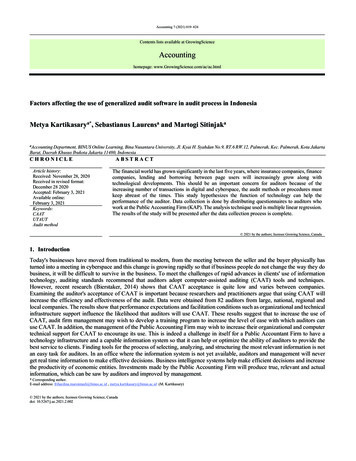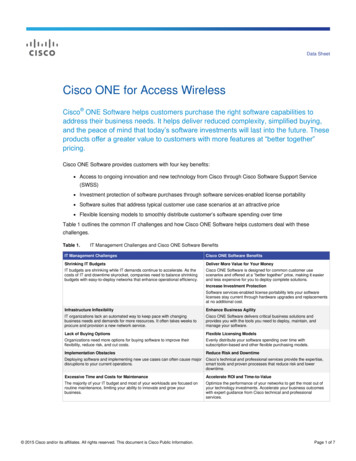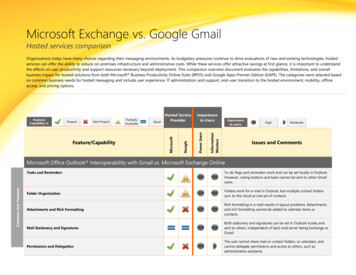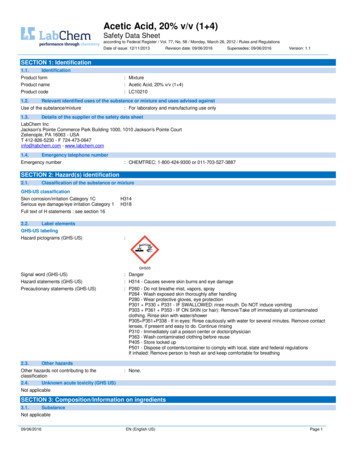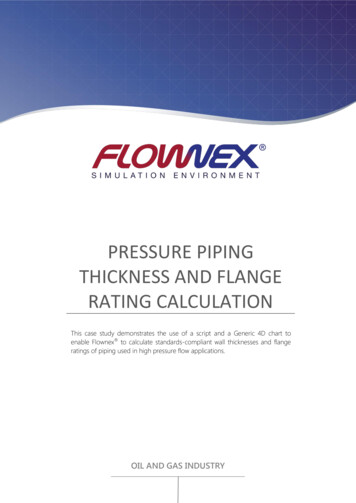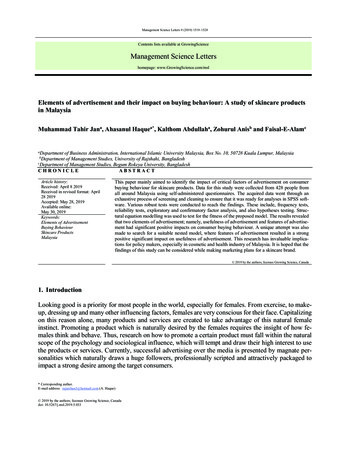
Transcription
Management Science Letters 9 (2019) 1519–1528Contents lists available at GrowingScienceManagement Science Lettershomepage: www.GrowingScience.com/mslElements of advertisement and their impact on buying behaviour: A study of skincare productsin MalaysiaMuhammad Tahir Jana, Ahasanul Haquea*, Kalthom Abdullaha, Zohurul Anisb and Faisal-E-AlamcaDepartmentof Business Administration, International Islamic University Malaysia, Box No. 10, 50728 Kuala Lumpur, Malaysiaof Management Studies, University of Rajshahi, BangladeshcDepartment of Management Studies, Begum Rokeya University, BangladeshCHRONICLEABSTRACTbDepartmentArticle history:Received: April 8 2019Received in revised format: April28 2019Accepted: May 28, 2019Available online:May 30, 2019Keywords:Elements of AdvertisementBuying BehaviourSkincare ProductsMalaysiaThis paper mainly aimed to identify the impact of critical factors of advertisement on consumerbuying behaviour for skincare products. Data for this study were collected from 428 people fromall around Malaysia using self-administered questionnaires. The acquired data went through anexhaustive process of screening and cleaning to ensure that it was ready for analyses in SPSS software. Various robust tests were conducted to reach the findings. These include, frequency tests,reliability tests, exploratory and confirmatory factor analysis, and also hypotheses testing. Structural equation modelling was used to test for the fitness of the proposed model. The results revealedthat two elements of advertisement; namely, usefulness of advertisement and features of advertisement had significant positive impacts on consumer buying behaviour. A unique attempt was alsomade to search for a suitable nested model, where features of advertisement resulted in a strongpositive significant impact on usefulness of advertisement. This research has invaluable implications for policy makers, especially in cosmetic and health industry of Malaysia. It is hoped that thefindings of this study can be considered while making marketing plans for a skincare brand. 2019 by the authors; licensee Growing Science, Canada1. IntroductionLooking good is a priority for most people in the world, especially for females. From exercise, to makeup, dressing up and many other influencing factors, females are very conscious for their face. Capitalizingon this reason alone, many products and services are created to take advantage of this natural femaleinstinct. Promoting a product which is naturally desired by the females requires the insight of how females think and behave. Thus, research on how to promote a certain product must fall within the naturalscope of the psychology and sociological influence, which will tempt and draw their high interest to usethe products or services. Currently, successful advertising over the media is presented by magnate personalities which naturally draws a huge followers, professionally scripted and attractively packaged toimpact a strong desire among the target consumers.* Corresponding author.E-mail address: rajarehan3@hotmail.com (A. Haque) 2019 by the authors; licensee Growing Science, Canadadoi: 10.5267/j.msl.2019.5.033
1520Observations made on advertisements of skin care products will always use beautiful models or famouscelebrities as a natural draw. Photos or videos are carefully scripted and beautifully presented. Captionsadded to them are carefully worded sentences to awe and inspire the potential buyers, and if it is a television commercial, narration is done in the most provocative and attractive oration to invoke the potentialcustomers’ interest. Claims are made of the many benefits or advantages of using such products andreinforced by the beautiful image presented by the models representing or promoting such skincare products. To add value, supportive documents or verification from bodies of authority are presented alongsideto gain public confidence. Playing on the psychology of the female consumers is not a difficult task, ifthey can be convinced that by using such a product they will look better and beautiful and they can beswayed irrespective of the cost or even the hidden potential risks which may be attached to them. Thepower of advertisement is to win over the mind and the heart of the potential customers, sometimes atwhatever cost.1.1. Objectives of the studyThe general objective of this paper is, first, to extract the imperative factors from the extant literature thatare related to advertising; second, to develop a hypothetical linkage in light of the literature; and third, topropose a conceptual model combining all the important factors with their impacts on consumer buyingbehaviour. The specific objectives of the study are as follows:1. To find out the impact of the usefulness of various techniques of advertisements on consumerbuying behaviour.2. To identify the impact of exposure of information in advertisements on consumer buying behaviour.3. To investigate the impact of features of advertisement on consumers buying behaviour.In the following sections, the review of the literature is undertaken, where hypotheses are also put forwardfor empirical investigation. It is followed by presenting the proposed model of the study, research methodology, findings, and conclusion.2. Literature review2.1. Consumers Buying BehaviourConsumers buying behaviour in relation to advertising and its effectiveness has always been important(Ajzen, 2012). Most of the time, consumers buying behaviour is influenced by the advertisement of theproduct (Rasool et al., 2012), especially in the skincare products (Fatima & Lodhi, 2015; Shallu & Gupta,2013). Allen et al. (2016) argue that it is actually the emotional reaction that is developed after goingthrough an advertisement of a product that influences the consumer behaviour. However, sometimes theadvertisers exaggerate and over promise about the product’s benefits and advantages in such a tactfulmanner that consumers get influenced subconsciously. Psychologically it brings the consumer underpressure through the persuasiveness and makes them buy the advertised product (Simons et al., 2017).The same holds for cosmetics or skincare products (Hayder, 2017). This market is highly competitive innature and mainly comprises of the female. Consumer controls the market and marketers focus on different factors to attract greater number of customers. Such factors include the consumers’ buying habits,preferences, taste, like and dislikes. People are highly connected to certain skincare brands due to itsquality and evident results (Akhtar et al., 2016). They are associated emotionally with the brands andthey can wait for the product when there is a shortage on a particular product or services. This particularbehaviour of consumers is due to the fact that some skin care brands have effectively used advertising inorder to attract and retain the customers.
M. T. Jan et al. / Management Science Letters 9 (2019)15212.2. Usefulness of AdvertisingIn advertising, there are different types of medium that audience can access information from. Be itthrough television ads, social media, printed ads like magazines and newspapers, radio as well as individuals like friends, relatives, shopkeeper and beautician (in case of skin care). Every method is usefulin its own way. An effective advertisement creates a desire in viewers, listeners or readers’ mind. It alsoprovides information on how to fulfil desire and how to make the potential customer feel good aboutproducts. Different companies use various methods of advertising depending on their targeted marketsegments. Those methods do not have to be standardized because it involves distinct cultures, languages,beliefs and the consumers’ values. When a company makes its strategy for advertisement in UK throughwritten ads like newspaper and magazine, it may not be the same as in Pakistan. This is because thepeople’ living style in both countries are different. The people in UK are in habit of reading materialslike books and magazines while in Pakistan, they are relying more on television. Hence, it is crucial tomake a choice of medium of advertisement to deliver message. In recent years, advertising has becomea critical issue and it requires ethical consideration since good advertising helps customers choose theirproducts or services to fit their needs (Lee & Johnson, 2013). Moreover, if the consumers find that aparticular advertisement has important or useful information, they tend to get influence by these advertisements (Lin & Kim, 2016; Muk & Chung, 2015), hence impacting their behaviour towards a product/service. Based on the above literature, it is, therefore, hypothesised that:H1: Usefulness of advertisement has a positive impact on consumer buying behaviour.2.3. Exposure to InformationThe first step towards buying a product/service is once a person is informed about a particular productor service. Consumer will only plan to behave positively towards a product if they are properly informedabout a product, hence signifying the importance of exposure to information. This view is called wearin effects of advertisement, which means that a certain level of exposure to information has a significantpositive impact on consumer behaviour (Schmidt & Eisend, 2015). According to Schmidt and Eisend(2015), when the information about a brand is exposed to the consumer different times, it increases theawareness, which eventually influences the purchase behaviour. However, there is a disagreement in theliterature on the number of repeat exposure of information among scholars (Schmidt & Eisend, 2015;Yang et al., 2012). The literature does agree that exposure to information is an inevitable step to influenceconsumer’s attitude and behaviour. The same holds for skincare industry. Janiszewski et al. (2003) andSchmidt and Eisend (2015) argue that apart from exposure to the advertisement’s information, noveltyis also important to attract people. Therefore, a unique skincare product name, trademarks, photos, figurative signs, and advertising, which provide information about the skincare company to the public willinfluence consumer behaviour. A significant number of the people depend on television, radio, newspapers, online reviews, and video review, especially when they are making buying decisions and choices.Further, due to the growth of social media, people now-a-days are exposed to information around themmore conveniently. Once people are exposed to information, the next stage is familiarity with the brandand learning more about that particular brand (Schmidt & Eisend, 2015), hence impact their behaviour.Based on the above literature, it is, hypothesised that:H2: Exposure to information has a positive impact on consumer buying behaviour.2.4. Features of AdvertisementsMultimedia advertisements usually contain nonverbal auditory elements, such as music and sound effectsas well as nonverbal visual elements such as images and logos. Those features are the main underlyingcauses of choosing a product. Brands usually would use several features of advertisement, namely, aspirational feature, celebrity endorsement, and social responsibility feature, to promote products (Ahmed &
1522Ashfaq, 2013). The same features of advertisement could be used in skincare products. Aspirational advertisement is a type of advertisement that can be called as the most effective for young people. It contains the slogans and tag lines that can influence them to purchase particular product. Aspirational advertisements normally contain three main elements which are perfection, sex appeal, and status. Further,another important feature of advertisement is “celebrity endorsement” (Ahmed & Ashfaq, 2013; Mittal,2017). This kind of advertisement plays a very significant role and usually can attract almost every groupof people. This is because celebrity has the power to gain the people’ trust to purchase the product butno evidence proving that it could provide brand loyalty (Oakley, 2009). According to Ahmed and Ashfaq(2013), and Mittal (2017), when a celebrity endorses a brand, consumer’s purchase decision is most likelyinfluenced positively, particularly among young consumers. Next, social responsibility advertisementshighlight some social awareness and factors that can have positive effects on the society at large. Manyskincare brands use social responsible marketing in order to tell people that their products have minimumnegative impacts on the environment. According to a survey, women wearing skincare products feelconfident about themselves. Oakley (2009), and Tavassoli and Lee (2003) argue that many of the skincarebrands use strong story line to attract the users, particularly women, by ensuring them that the use of theirproducts will make them more confident to be part of the society. The aforementioned studies clearlyhighlight that various features on advertisements positively impact consumer behaviour. It is, therefore,hypothesised that:H3: Features of advertisement have positive impacts on consumer buying behaviour.3. The proposed modelAfter an extensive review of the literature, the proposed model is presented with four variables; namely,usefulness of advertisement (UoA), exposure to information (ETI), feature of advertisement (FoA) andconsumer buying behaviour (CBB). The model of this study is inspired from classical purchase behaviourmodel by Butler and Peppard (2008) where five important sequential stages are highlighted. In this research, the three (3) independent variables are related to information search stage. The dependent variable, consumer buying behaviour, can be related to the purchase stage of consumer decision makingmodel. Fig. 1 depicts the model of this study.Fig. 1. Propose framework of the study3.1. Research methodologyThis research is quantitative in nature, where a self-administered questionnaire was developed from previous studies. The questions in the questionnaire was slightly altered to suit the scope of the presentstudy, which was skincare products. Further, the final questionnaire was distributed to the selected respondents using social media, specifically, WhatsApp and Instagram. Participants were requested to answer questions to two major sections, where section A was on the four (4) variables of the study, andsection B was on the demographic variables.
M. T. Jan et al. / Management Science Letters 9 (2019)15233.2. Data CollectionData was collected for this research using a self-administered questionnaire distributed online using social media platforms. First, the questionnaire was developed virtually using Google forms, for the easeof sending it out online. Second, the link of the developed virtual (softcopy) questionnaire was sharedwith the potential respondents. The data was gathered from those people who use cosmetics (skincare)products. All the respondents reside in Malaysia. A total of 600 questionnaires were distributed but 428usable questionnaires were selected for final data analysis. The collected data was analysed using SPSSand AMOS software.3.3. Measurement DevelopmentThe questionnaire for this study was developed based on previously validated measures. It is importantto note that all the items in the questionnaire were modified to fit the current study’s context. A 5-pointLikert scale was used, ranking from strongly disagree (1) to strongly agree (5).4. The resultsIn the questionnaire, a section on the respondents’ profile was included in order to obtain some basicinformation about them. The first step in the data analyses considered important was to determine thesample’s characteristics. For this purpose, descriptive statistics were employed. Overall, 80.8 percent ofthe females responded to the survey followed by 19.2 percent of males, indicating a higher influence ofthe female group. The figures also revealed that 54.9 percent of the respondents were from 21 to 25 yearsold, whereas the category of 16 to 20 years old was the second major age group with 31.3 percent response. Almost all respondents were Malaysian with the number of 418 respondents (97.7%). For respondents’ education, the majority (262 or 61.2%) were degree holders followed by diploma studentswith a total contribution of 24.1 percent. Detailed descriptive analyses is provided in Table 1.Table 1Demographic Profile of the RespondentsDemographic VariablesGenderAgeNationalityMarital StatusEducational backgroundMaleFemale16 – 20 years21 – 25 years26 – 30 years31 – 35 years36 – 40 years40 and aboveMalaysianNon MalaysianSingleMarriedPrimary educationHigh SchoolCertificateDiplomaDegreeMastersPhDResearch sample (n 428)Number of 84.210324.126261.271.620.5Almost 68.5 percent of the respondents fall in the student group and 108 respondents (or 25.2%) wereemployed. In terms of skincare products, the results revealed that 79 percent of the respondents had usedfacial cleanser regularly compared with toner, serum, moisturizer, anti-aging cream and sun screen. Theoutcome also showed that majority (281 or 65.7%) purchased skincare products only when they needed
1524it, whereas 17.1 percent of the respondents bought skincare products once a month. With regard to spending, 49.1 percent of the total respondents claimed that they were average spender and only 5.8% (25respondents) states that they were the heavy spender. Lastly, the results of usage frequency of skincareproducts showed that almost 80.8 percent (or 346) respondents used it daily, whereas 5.1 percent of therespondents used skincare products rarely. Detailed descriptive analyses are found in Table 2.Table 2Demographic Profile of the RespondentsDemographic VariablesOccupationIncomeSkincare ProductFrequency of buyingSpending on skincareFrequency of useStudentEmployedUnemployedRetired RM 1000RM 1000- RM 3000RM 3000 – RM 5000 RM 5000Facial CleanserTonerSerumMoisturizerAnti-Aging CreamSun ScreenOnce a monthTwice a monthOnce in two monthsAs per needHeavy SpenderModerate SpenderAverage SpenderDon’t spend at allDailyFrequentlyOccasionallyRarelyResearch sample (n 428)Number of 19.6194.4225.14.1. Attributes of the questionnaireCronbach’s alpha reliability coefficient and the item to-total correlation were calculated to examine thestability and consistency of the research instrument. According to Nunnally (1978), the value ofCronbach’s alpha closer to 1 indicates greater stability and consistency; however, the threshold value inmost research studies is set at 0.60. The present research instrument resulted in an alpha value of 0.857,attesting an acceptable consistency and stability of the research instrument (see Table 3).Table 3Reliability Statistics of the QuestionnaireCronbach's AlphaCronbach's Alpha Based on Standardized Items0.8510.857No. of Items384.2 Exploratory factor analysisThe Kaiser-Meyer-Olkin (KMO) and Bartlett’s Test of Sphericity were examined to investigate the correlations among variables. In this case, KMO was 0.842 and Bartlett’s Test of Sphericity was significant
1525M. T. Jan et al. / Management Science Letters 9 (2019)at p 0.001, indicating that the present data was suitable for factor analysis and there is sufficient correlations between the variables.Table 4KMO and Bartlett’s Test of SphericityKMO and Bartlett's TestKaiser-Meyer-Olkin Measure of Sampling Adequacy.Approx. Chi-SquaredfBartlett's Test of SphericitySig.8464642.63351.000The result of exploratory factor analysis (hereafter, EFA) indicated a clean four-factor structure using thecriteria of an eigenvalue greater than 1. The extracted factors accounted for 49.74 percent of the totalvariance. Factor loadings were all higher than 0.4 on its own factor and therefore, each item loaded higheron its associated construct than on any other construct; supporting discriminant validity of the measurement. The results of EFA are shown in Table 5.Table 5Results of Factor AnalysisItems ETI5ETI2CBB2CBB1CBB6CBB5Initial Eigenvalues% of VarianceCumulative %Factor .6240.6160.5370.4650.426Factor 2UsefulnessofAdsComponentFactor 3ExposuretoInformationFactor 1.7157.55649.7414.3. Confirmatory factor analysisThis study adopted a two-stage structural equation modelling technique, where the extracted factors during EFA were confirmed followed by testing the fitness of full structural model and testing the hypotheses. For this purpose, AMOS software was used with maximum likelihood estimation (MLE). In order
1526to perform confirmatory factor analysis (hereafter, CFA), recommendations of scholars (Byrne, 2010;Hair et al., 2010; Kline, 2011) were kept in mind. These recommendations include checking Chi-square(χ2), the comparative fit index (CFI), the using normed chi-square (χ²/df), and the root mean square errorof approximation (RMSEA). Fig. 2 presents the measurement model of the study.Fig. 2. Confirmatory Factor AnalysisFig. 3. Full Structural ModelThe result of the CFA indicated a good fit with the normed Chi-square (χ²/df) value of 3.15, which iswell below the threshold of 5.0. Similarly, other fit indices like CFI was also acceptable with the valueof 0.928 (which is also above the recommended value of 0.9). Lastly, the value of RMSEA below 0.08is considered acceptable, in the present case, it was 0.079, which attests a good fit of the measurement.4.4 Full Structural ModellingIn the two-stage SEM approach, once the measurement model is fit, one can proceed with testing thefitness of full structural model and to perform hypotheses testing. In order to test the full-fledge model,the fit indices considered were Chi-square (χ2), the comparative fit index (CFI), the using normed Chisquare (χ²/df), and the root mean square error of approximation (RMSEA), as recommended by Byrne(2010), Hair et al. (2010), and Kline (2011). Fig. 3 depicts the full-fledged structural model followed byhypotheses testing. The final structural model also resulted in a very good fit with the normed Chi-square(χ²/df) value of 3.15. This value of normed chi-square (χ²/df) is below the recommended threshold of 5.0.The value of CFI was also above 0.9 (in this case 0.928), and RMSEA below 0.08 (in this case 0.07), allindicating a good fit of the final structural model. The hypothesized causal linkages were also observedand we found enough evidence to support only two linkages (the causal link between ‘features of ads’and ‘consumer buying behaviour’ with the β value of 0.34 and p 0.001, and ‘usefulness of ads’ and‘consumer buying behaviour’ with the β value of 0.18 and p 0.001), whereas, this study did not findevidence to support the causal link between ‘exposure to information’ and ‘consumer buying behaviour’.This means that H1 and H3 are supported, whereas, H2 is not supported. Table 6 summarises the resultsof hypotheses testing.Table 6Results of hypotheses testingStructural pathUsefulness of Ads Consumer Buying BehaviourExposure to Information Consumer Buying BehaviourFeatures of Ads Consumer Buying BehaviourStatisticChi-square significanceNormed chi-square (CMIN/df)Comparative fit index (CFI)Root mean error square of approximation (RMSEA)s Supported, ns Not .Weight0.1780.0320.338Suggested 0.05 5.00 0.90 0.08S. E.C. 90.9280.0790.0060.537***
M. T. Jan et al. / Management Science Letters 9 (2019)1527Table 6 shows the detailed results of hypotheses testing along with the fit indices of the final structuralmodel. In this case, H1 (Usefulness of ads have a positive impact on consumer buying behaviour) and H3(features of ads have a positive impact on consumer buying behaviour) emerged with positive significantrelationship, as envisaged. However, H2 (exposure to information have a positive impact on consumerbuying behaviour) does not result in significance.4.5. Nested ModelAn interesting and a novel attempt was made in the present research by exploring various causal relationships and testing them for significance and robustness using fit indices. This attempt was apart fromthe proposed model, where three (3) causal linkages were developed based on the review of the literature,and were tested using SEM. The process of searching for possible relationships in the existing model andcoming up with another good and sensible model is called nested modelling. In the present case, variousunique relationships were tested but one stood-out from the rest and is presented in Fig. 4.Fig. 4. Nested ModelAs evident, in the nested model a new causal link was tested (which is the link between ‘features of ads’and ‘usefulness of ads’). Interestingly, this link emerged with a very strong positive significant impact.In this case, the β value of 0.58 and p-value of less than 0.00 attest a very strong impact. The overall fitof the model also slightly improved and are acceptable. This particular link means that various featuresof advertisement strongly impact the usefulness of advertisement, which eventually impacts the buyingbehaviour of consumers.5. Conclusion, implication and direction for future researchThe main purpose of this research was to analyse the impact of various elements of advertisement onconsumer buying behaviour. The findings of this research have identified and tested factors that are responsible for consumers buying behaviour with skincare products in Malaysia. It was revealed that in theelements of advertisement, two (2) elements are of prime importance, namely; usefulness of advertisement and features of advertisement. Even though exposure to information is also important but this research did not find evidence to support it. Consumers demand for different items based on their tastes,preferences and also the influence from third party. How useful an ad is, determines people’s behaviourtowards the company and product. Similarly, features of ads also alter people’s behaviour positively.This means that companies, particularly, skincare products producers have to focus on the usefulness ofadvertisements, along with paying attention to enhancing the features of their ads. It is because these twowill eventually positively influence consumers buying behaviour. Future researchers may replicate themodel of the present study in other countries and other industries. A promising attempt would be to testthe nested model proposed in this study. Moreover, future researchers may consider undertaking a qualitative approach to acquire more in-depth information about the elements of advertisement and their impact on consumer buying behaviour.
1528ReferencesAhmed, S., & Ashfaq, A. (2013). Impact of Advertising on Consumers’ buying behavior through Persuasiveness, Brand Image, and Celebrity endorsement. Global Media Journal, 6(2), 149.Ajzen, I., Albarracin, D., & Hornik, R. (Eds.). (2012). Prediction and change of health behavior: Applying the reasoned action approach. Psychology Press.Akhtar, N., Siddiqi, U. I., Ashraf, A., & Latif, M. (2016). Impact of a Brand Equity on Consumer Purchase Decision in L'Oreal Skincare Products. International Review of Management and Business Research, 5(3), 808.Byrne, B. M. (2010). Structural equation modeling with AMOS: Basic concepts, applications, andprogramming (2nd ed.). New York, NY: Taylor and Francis Group.Butler, P., & Peppard, J. (1998). Consumer purchasing on the Internet: Processes and prospects. European Management Journal, 15(6), 600–610.Fatima, S., & Lodhi, S. (2015). Impact of Advertisement on Buying Behaviours of the Consumers: Studyof Cosmetic Industry in Karachi City. International journal of management sciences and businessresearch, 4 (10).Hair, J. F., Black, W. C., Babin, B. J., & Anderson, R. E. (2010). Multivariate Data Analysis (7th ed.).New Jersey: Pearson Prentice Hall.Hayder, N. B. (2017). Deceptive Advertising and Purchase Behavior of University students: A Study onSkin-Care Products in Bangladesh. Global Journal of Management And Business Research.Janiszewski, C., Noel, H., & Sawyer, A. G. (2003). A meta-analysis of the spacing effect in verbal learning: Implications for research on advertising repetition and consumer memory. Journal of consumerresearch, 30(1), 138-149.Kline, R. B. (2011). Principles and Practice of Structural Equation Modeling (3rd ed.).Lin, C. A., & Kim, T. (2016). Predicting user response to sponsored advertising on social media via thetechnology acceptance model. Computers in Human Behavior, 64, 710-718.Lee, M., & Johnson, C. (2013). Principles of advertising: a global perspective. Routledge.Mittal, M. (2017). Impact of Celebrity Endorsements on Advertisement Effectiveness & Purchase Decision Among Youths. International Journal of Marketing & Business Communication, 6(4).Muk, A., & Chung, C. (2015). Applying the technology acceptance model in a two-country study of SMSadvertising. Journal of Business Research, 68(1), 1-6.Nunnally, J. (1978). Psychometric methods.Oakley, H. (2009). An evaluation of current techniques in cosmetic advertising and an assessment oftheir effectiveness on the contemporary consumer (Doctoral dissertation, Dissertation for the MScDegree in Creative Advertising. Edinburgh Napier University, 2009. –209 p).Rasool, M. S., Rafique, Y., Naseem, M. A., Javaid, S., Najeeb, M., & Hannan, M. (2012). Impact ofadvertisement on consumer behavior of FMCG in Lahore city. Academic Research International, 2(3), 571.Shallu, M., & Gupta, S. (2013). Impact of promotional
viduals like friends, relatives, shopkeeper and beautician (in case of skin care). Every method is useful in its own way. An effective advertisement creates a desire in viewers, listeners or readers’ mind. It also provides information on how to fulfil desire and how
